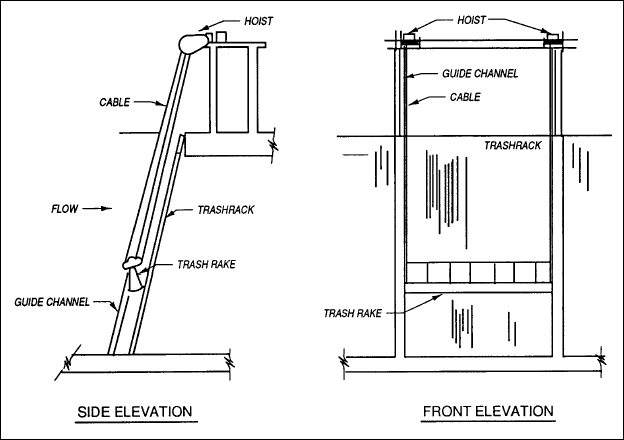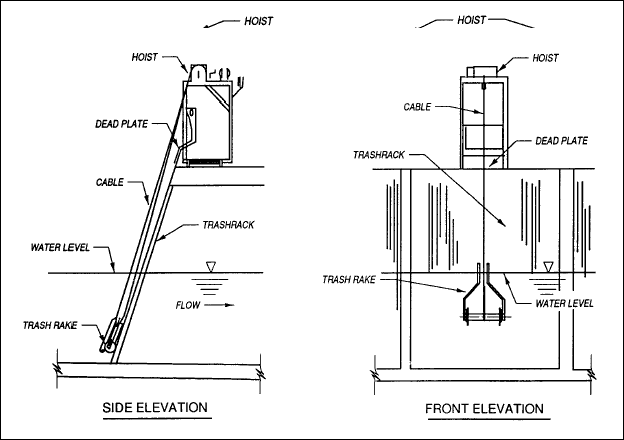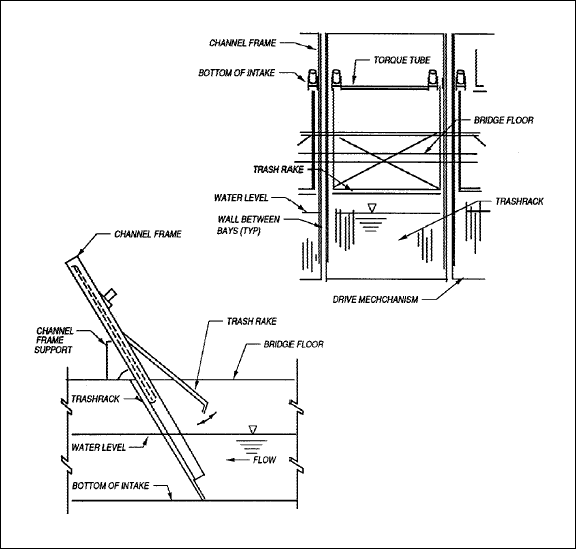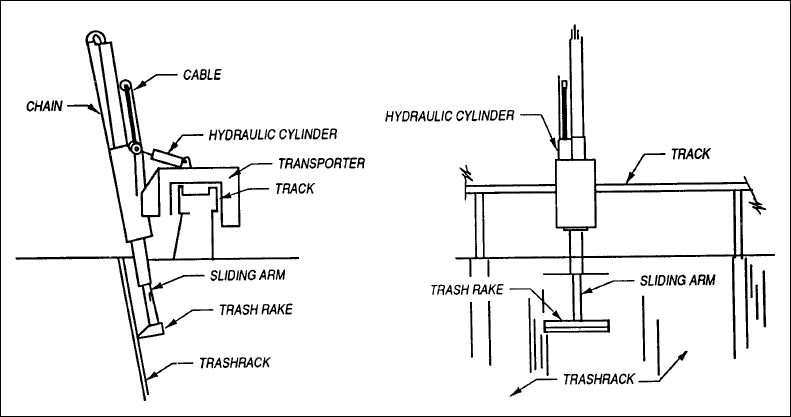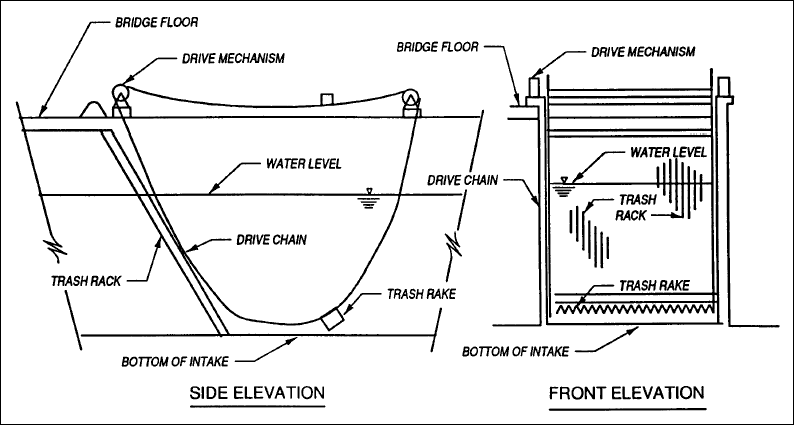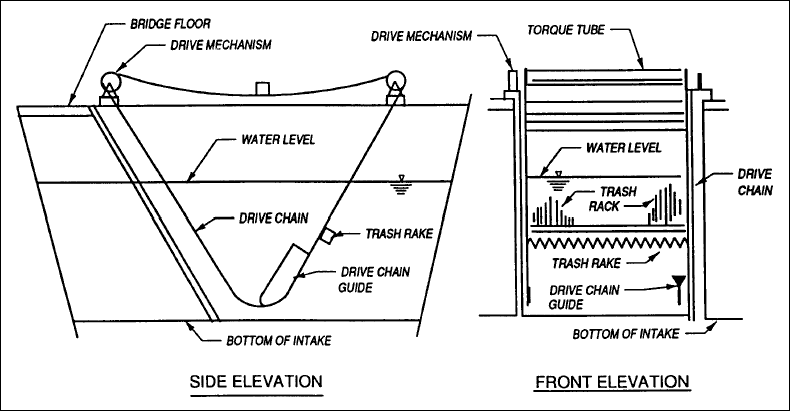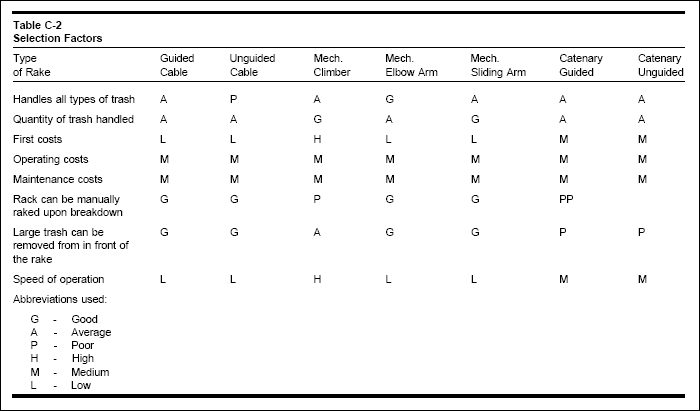( a ) Cable hoists.
(1) General. Cable hoist trashrakes use wire rope hoists to move the rake up and down to clean the trashrack. The rake portion can be the guided or unguided type.
(2) Guide cable hoist trashrakes. Guided cable trashrakes cover the full width of a set of trashracks. Fixed channels at each side of the rack section or pump bay guide the rake up and down in front of the trashrack. The trashrake is raised and lowered along the front face of the trashrack by a cable hoisting system. The rake is lowered by gravity and raised by the hoist machinery. The teeth of the rake are designed to pull away from the rack during lowering and are engaged into the rack when the rake is raised. The width of the rake is usually limited to 4.57 meters (15 feet) with the vertical travel limited to about 12 meters (40 feet). The rake can discharge into a removable cart for transporting to a location for trash removal by a truck. The entire trashrake can be power driven to run on rails for use in multiple pump bays or can be fixed at one location. The electrical power is supplied to the rake by means of a cable on a pull out reel or from a fixed bus bar with a trolley collector. Electrical controls consist of lower and upper limit switches and hoist overload protection. A typical arrangement of the guided cable hoist trashrake is shown on Figure C-2. The trash removal capability of the guided cable hoist trashrake would include material classes 1, 2, 3, and 4. The handling ability of class 4 debris depends on the size of the rake and how far the teeth of the rake clear the rack when the rake is being lowered.
(3) Unguided cable hoist trash guides. Unguided cable hoist trashrakes are similar to the guided types except that the rake is not restrained by guides on the sides (Figure C-3). The rake moves up and down the trashrack on wheels. Except for the guided provisions, the unguided mechanism is very similar to the guided cable hoist trashrake. The width of these rakes are limited to approximately 10 feet, and the vertical travel ranges up to 40 feet. The trash removal capability of the unguided cable hoist trashrake would include material classes 1, 2, 3, and 4. This type of rake tends to lose trash when being raised and has had overall poor performance in some Corps-designed structures when compared with the guided type of rake.
( b ) Mechanical trashrakes.
(1) General. Mechanical trashrakes use chains, levers or arms, hydraulic cylinders and gears to move the rake up and down to remove the trash from the trashrack. Four types of mechanical trashrakes are described below. The types are climber, elbow arm, sliding arm, and chain driven.
(2) Climber trashrakes. The climber-type mechanical trashrake consists of a rake that covers a full bay width and is raised and lowered along guides and driven by sprockets on the rake assembly that mesh with a fixed roller chain or rack attached to the side guides. The rake assembly rotates around a pivot which permits the rake to rise from the trashrack when lowered and mesh with the trashrack when raised. The rake is driven positively during both the up and down movements. The rake is supported by a superstructure above the operating level. The side guide bars, motor drive mechanism, and other moving parts are located above the operating floor level. A climber trashrake would be required for each pump bay since they are fixed at one location. A climber trashrake can be obtained to rake trashracks that are up to 9 meters (30 feet) wide and 12 meters (40 feet) deep. The rack needs to be inclined for this type of rake. The electric controls consist of lower and upper limit switches along with motor overload provisions. The controls can permit a complete operation cycle of the rake with one activation. A typical arrangement of the climber type mechanical trashrake is shown on Figure C-4. The trash removal capability of the climber type mechanical trashrake would include trash material classes 1, 2, 3, and 4. The handling ability of classes 3 and 4 depend on the length of the trash item and its effective diameter. The width of the rake and the distance the teeth retract from the face of the trashrack determine the rakes capacity to remove large trash.
(3) Elbow arm-type trashrakes. The elbow-type unit consists of a rake on the end of a two-piece arm similar to that used on a backhoe. The arm is moved by means of a hydraulic cylinder. In addition to the up and down movement of the rake, it also can be made to pivot where attached to the operating platform, thus allowing it to sweep a greater width and provide unloading capability adjacent to the rake unit. For a station with multiple pumps, the rake unit is mounted on a traveling platform allowing its operation in front of any pump. The rake is limited to a width of 3.0 meters (10 feet), and the raking depth can vary to 8.7 meters (25 feet). Manual control of the rake is performed by an operator from a cab located on the platform. This rake also has the advantage of power down movement rather then depending on gravity forces to lower the rake. A typical arrangement of the elbow type trashrake is shown on Figure C-5. The trash removal capability of the elbow-type rake would include material classes 1, 2, 3, 4, and 5.
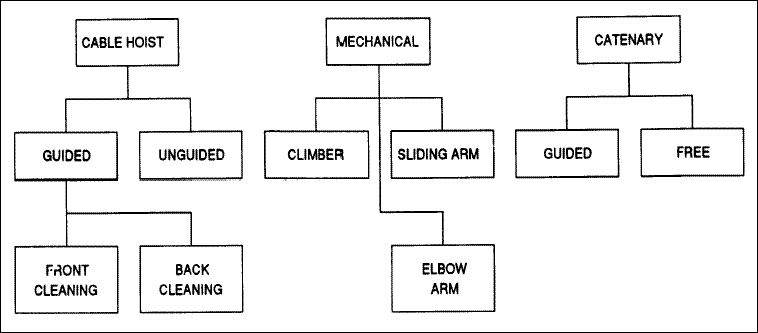
Figure C - 1 : Trashrake categories.
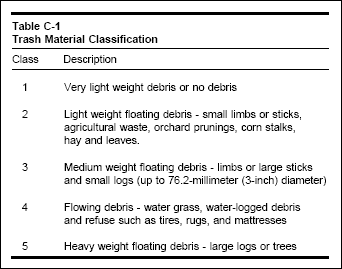
(4) Sliding arm trashrakes. Sliding arm or telescoping arm rakes consist of a pivoting boom assembly supported from a frame. The boom assembly supports a sliding rake arm that allows the rake to be lowered and raised. Pivoting of the boom assembly also allows the rake arm to be moved away from or to the trashrack. The frame supporting the rake can be permanently fixed at one location for raking only one trashrack or can be mounted on a rail-supported platform which would permit one unit to rake multiple trashracks. The rake can empty into a cart onto the operating platform. This rake can be obtained in widths up to 4.6 meters (15 feet) and rake racks to 8.7 meters (25 feet) deep. The controls can permit a complete operation cycle of the rake with one activation. A typical arrangement of the sliding arm trashrake is shown on Figure C-6. The trash removal capability of the sliding arm trashrake would include material classes 1, 2, 3, and 4. The ability to handle classes 3 and 4 depends on the rake arm being able to clear the trash on the downward movement of the rake arm.
( c ) Catenary trashrakes.
(1) General. Two types of catenary trashrakes are unguided (free hanging) and guided. Both types consist of a chain on each side, supported by two sprockets that hang down the front of the trashrack. Several beams with teeth attached (rakes) have each end connected to each chain. The continuous movement of the chain drags the beams across the rack. The beams are held into the rack by gravity. This type of rake can be used for racks up to 12.2 meters (40 feet) wide with depths up to 12.2 meters (40 feet). The chains are motor driven utilizing gearing and drive shafts similar to dam tainter gate machinery. Since the beams rub along the trashrack, care must be given to the alignment of the racks so that it provides a smooth surface without any projections for the rake beams to catch on.
(2) Unguided catenary trashrakes. The unguided catenary trashrake consists of a free-hanging chain with rake beams spaced approximately every 3.0 to 4.6 meters (10 to 15 feet) along the chain. The chains are supported by an idler sprocket at the top of the trashrack and a driven sprocket located at the same elevation as the idler sprocket and a sufficient distance from the trashrack so that the free hanging chain makes contact with the bottom of the rack. A typical unguided catenary trashrake is shown on Figure C-7. The trash removal capability of the unguided catenary trashrake would include material classes 1 and 2 with some limited capability of classes 3 and 4. Items of size greater than the depth of the rake beams are usually not removed by the rakes.
(3) Guided catenary trashrakes. The guided catenary trashrake is the same as the unguided catenary trashrake except that the down leg of the chain from the driven sprocket is guided to ensure that the chain reaches the bottom of the rack. A typical guided catenary trashrake is shown on Figure C-8. The trash removal capability of the guided trashrake would include material classes 1 and 2. As with the unguided type, this rake can on a limited basis handle some class 3 and 4 material depending on its size.
